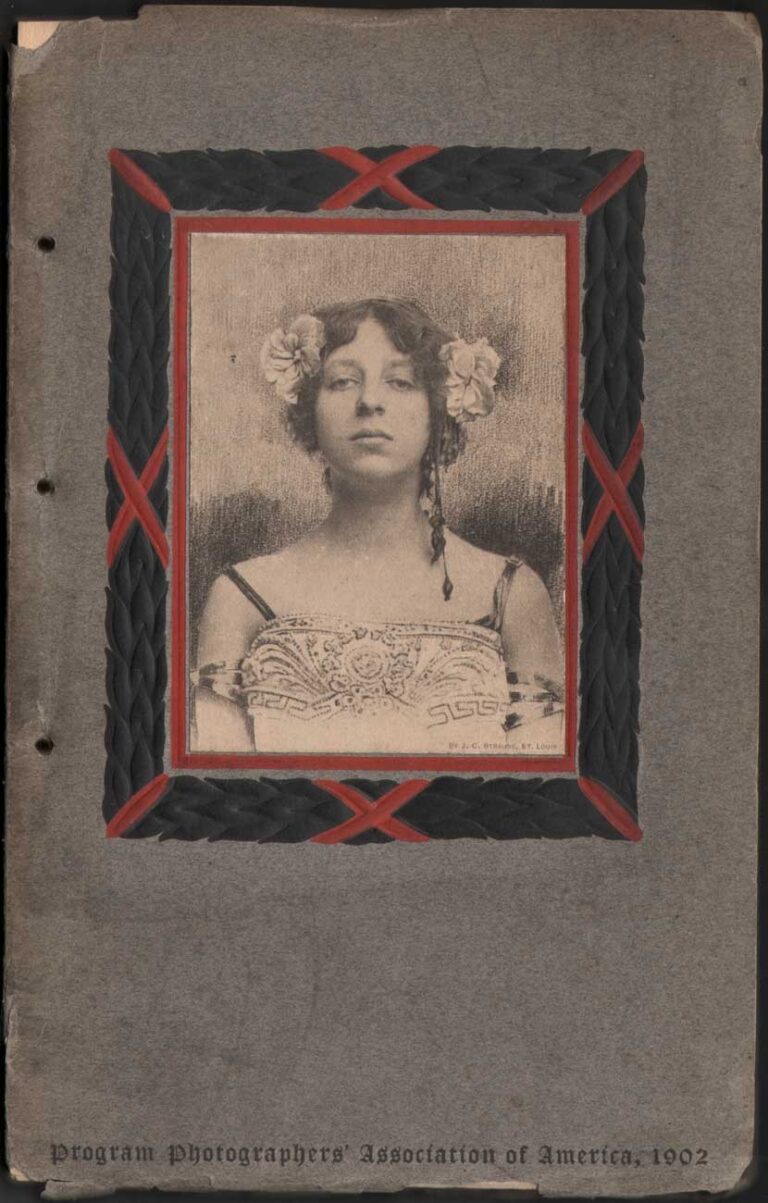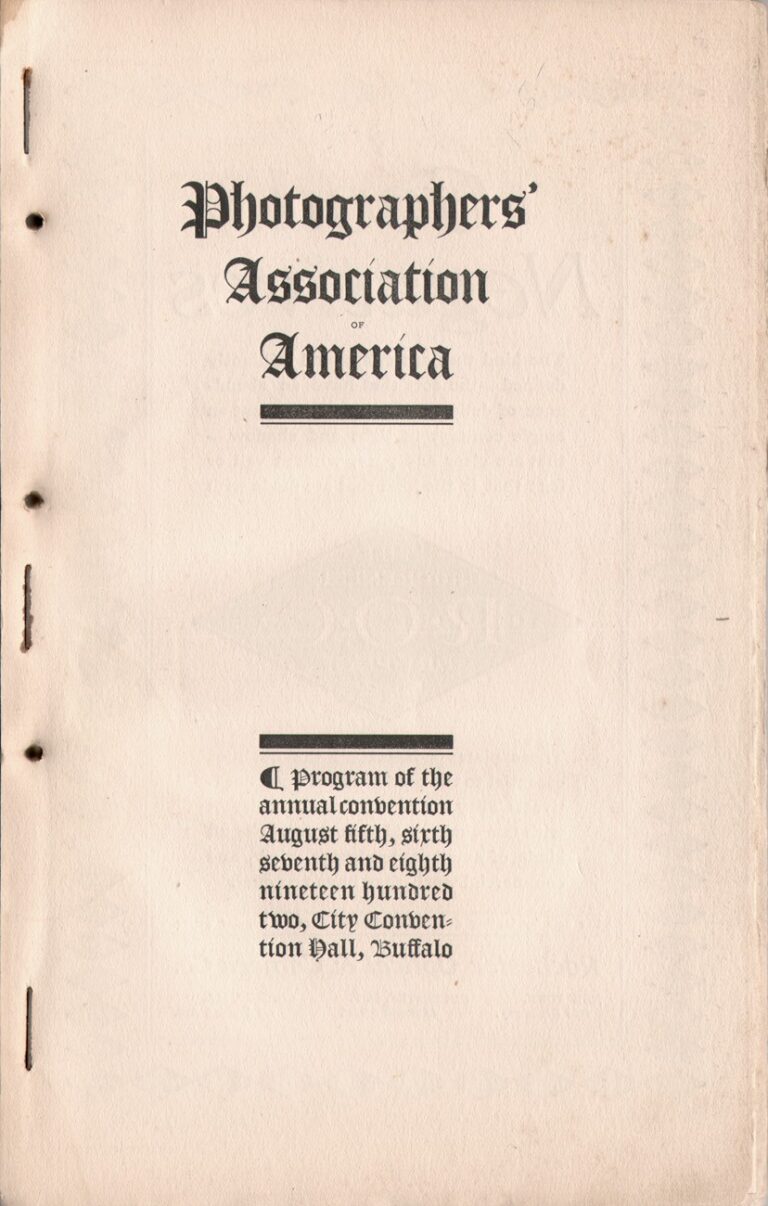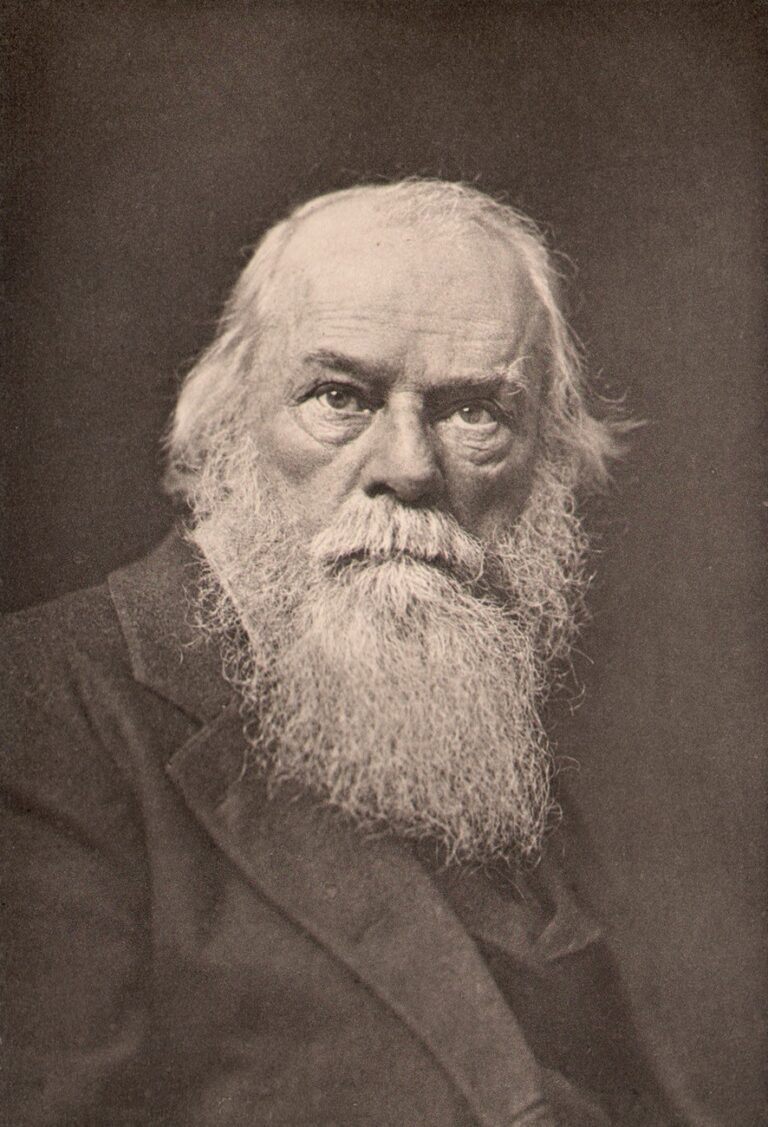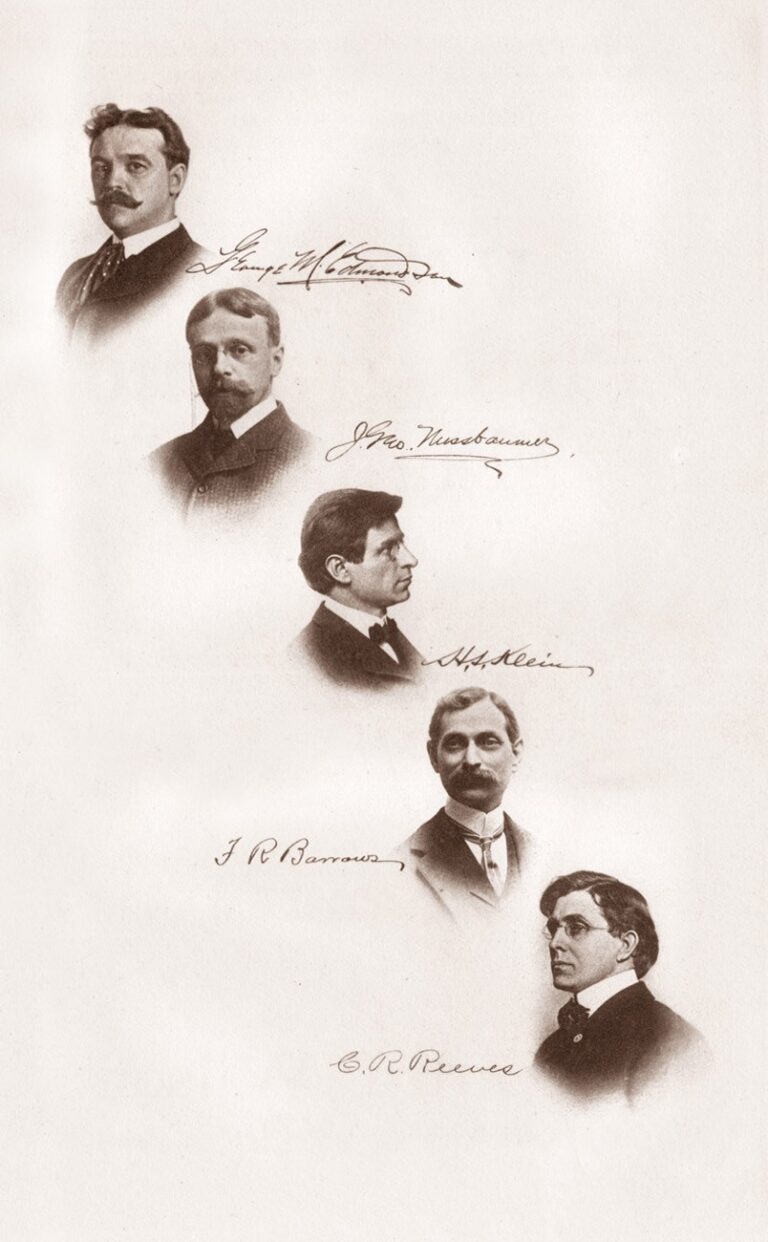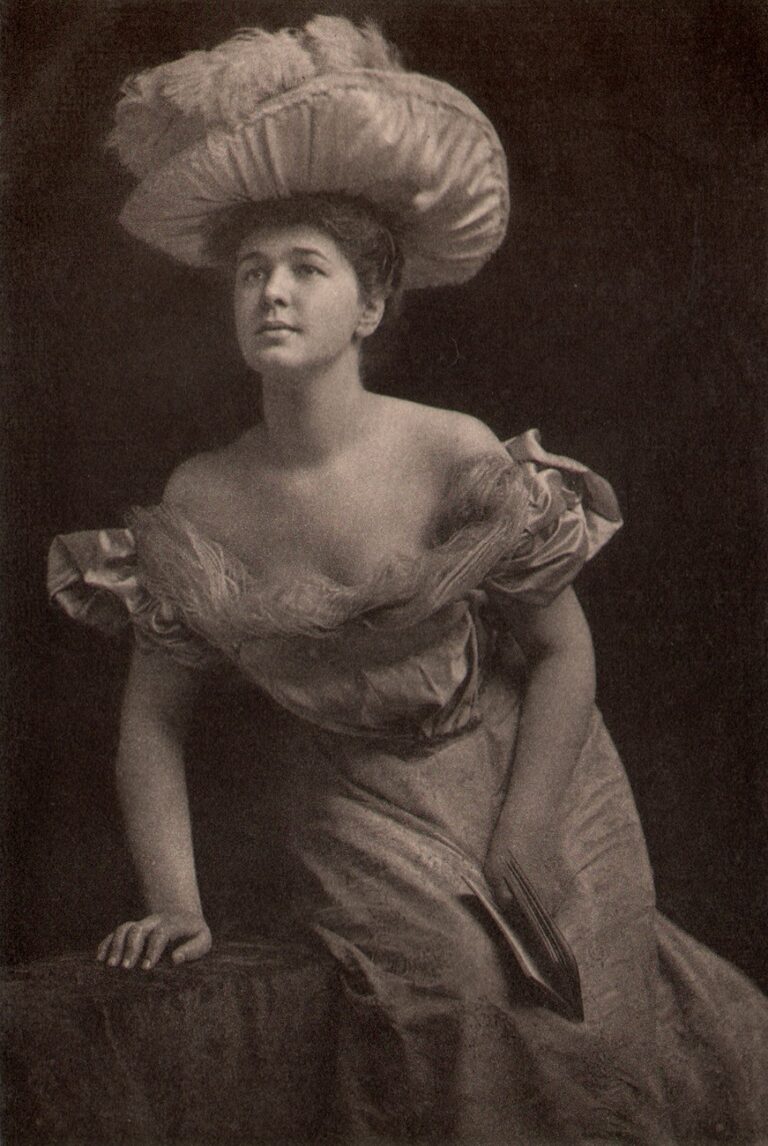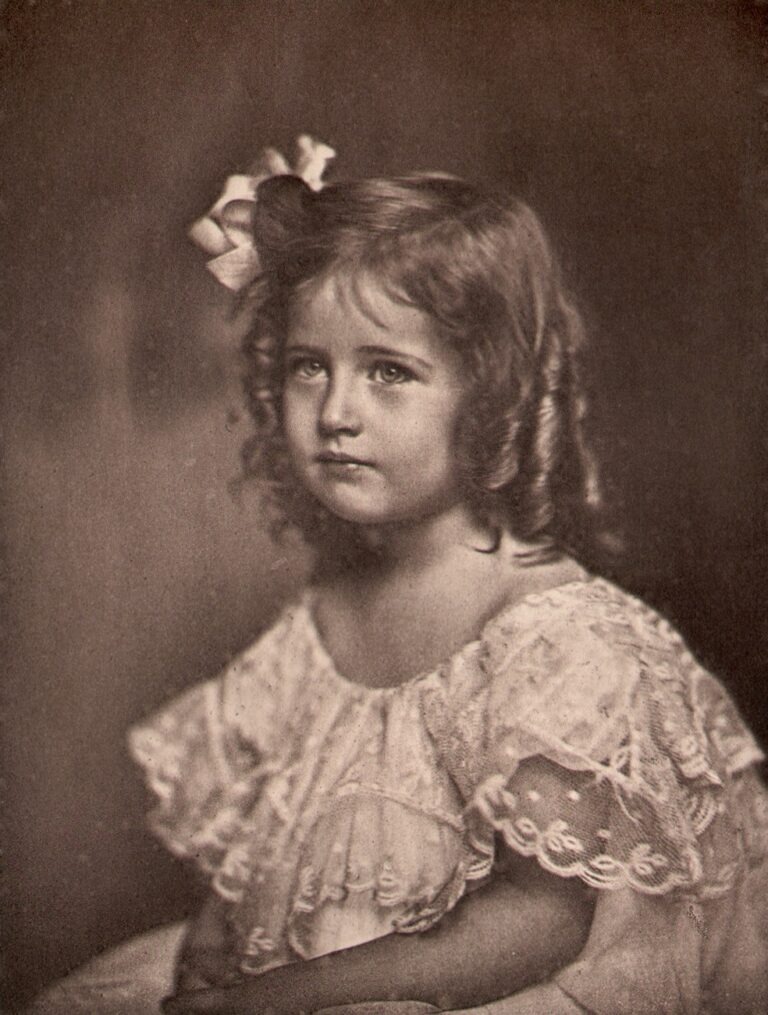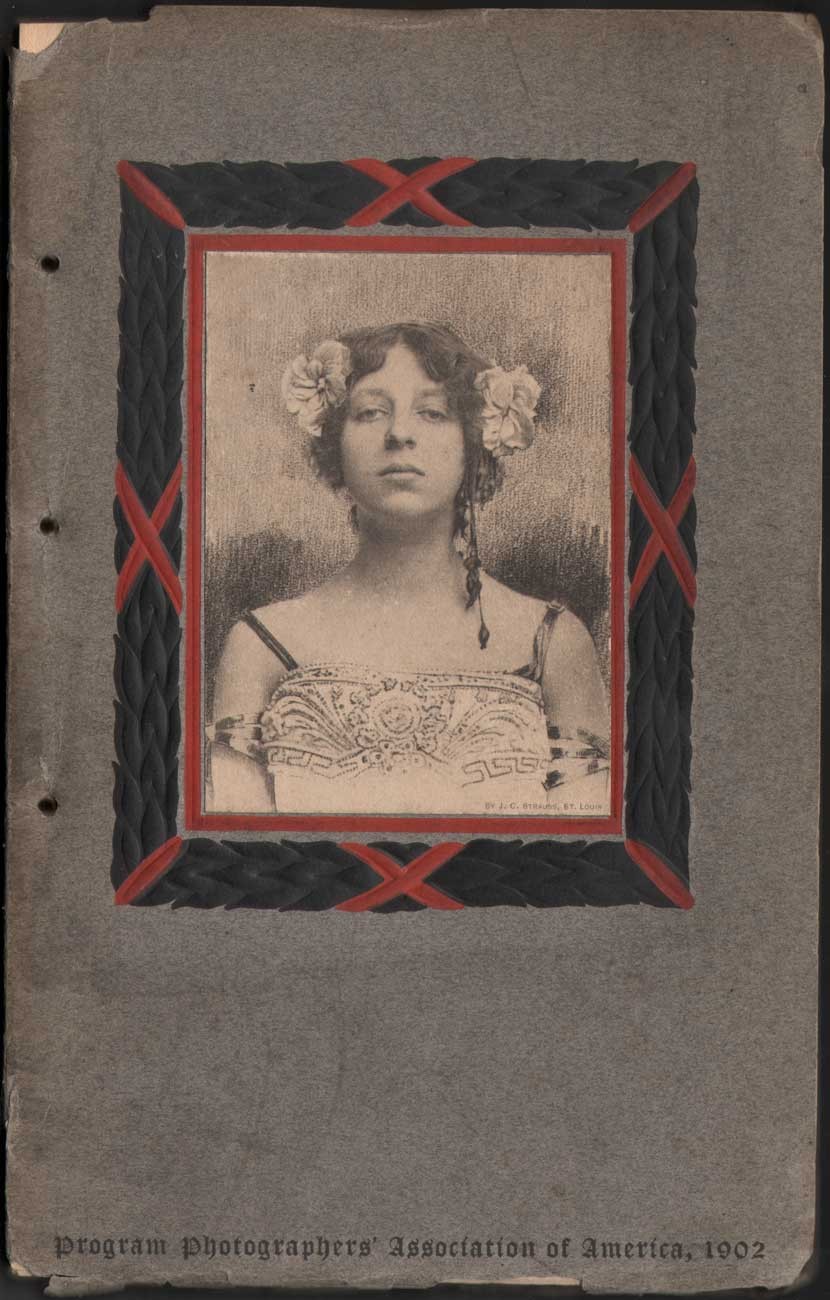
Program: Photographers’ Association of America, 1902
Held in the City Convention Hall in Buffalo, New York from August 5-8, 1902, the annual convention of the Photographers Association of America (PAA) issued this program book for all active and associate members. Planning for the volume was conceived during a meeting of the Executive Committee of the PAA who had met earlier in the year in Buffalo on January 14th, 1902. The March issue of the Photographic Times reported:
The Secretary was instructed to publish a souvenir, and to insert the names and addresses of all the members and associate members of the Association, and to mail to each member of the Association a copy of the souvenir thirty (30) days before the Convention.
After the end of the convention, the souvenir book was described in The Photo-Miniature:
The convention souvenir of the Photographers’ Association of America deserves mention as the most creditable piece of work of its sort we have seen. It is a book of one hundred pages, six by nine and one-half inches, printed on deckel-edged laid linen of soft color, and enclosed within a tasteful gray cover, illumined with a Lytrit portrait, by J. C. Strauss, of St. Louis. Numerous photogravures add further attractiveness to the volume, which contains the programme of the convention, the constitution and laws of the association, and a list of its members. (1.)
Known today as the Professional Photographers of America (PPA) and based in Atlanta, Georgia, the Photographers Association of America first came into existence in 1880, when the “Chicago Photographic Association and former members of the defunct National Photographic Association” joined forces. (2.) The PPA website further states that in 1880:
“PAA elected John Ryder from Cleveland, Ohio, as its first president. A group of 237 photographers attended the first convention in Chicago on August 23-26.” (3.)
This unpaginated, staple-bound program devotes most of its’ pages to lists of active and associate members and employees. Originally, the pictorial card cover, which features an embossed-framed, glued-photogravure of a “Lytrit” style portrait by St. Louis commercial photographer Julius Caesar Straus, was held in place by a knotted cord strung through three punch holes in the program itself. In addition to tastefully designed period advertisements for everything from manufacturers of photographic chemicals, mounts, lenses and periodicals, it is enhanced by seven, hand-pulled photogravure plates showcasing members work printed by the atelier John Andrew & Son of Boston. The following is a breakdown summary of members, associate members and employees who are listed with their home address of city, town, etc. and state:
active members: 30 pages: 1060 (approximate)
associate members: 7 pages: 215 (approximate)
employees: 8 pages: 325 (approximate)
A forward to this program book signed: The Executive Committee in total reads as follows:
To the Photographers of America
The Executive Committee takes pleasure in presenting this Program of the Twenty Second Annual Convention of the Photographers’ Association of America, and invite your presence at the meeting, and ask your assistance in making this the most profitable and enjoyable convention in the history of the association.
To the generous advertisers whose support has made it possible to publish this souvenir program we make acknowledgment of appreciation, and bespeak for them a liberal patronage of our members.
The convention’s agenda was printed for each of the four days in the program book:
PROGRAM
TUESDAY, AUGUST 5, 1902
10:00 A.M.
Opening of Convention.
Address of welcome.
Reading of communications.
Reports of committees.
Address by Prof. A.N. Griffith, of Detroit.
Annual address by the President of the P. A. of A., George M. Edmondson
3:00 P.M.
Reading of communications.
A talk by V. H. Smith, of Rochester. Subject: Why?
(20 minutes.)
A practical studio talk. A photographer-demonstrator’s
views on the “little things” in the business, that mean success.
Lecture by Lucius W. Hitchcock, of Buffalo. Subject:
Practical Composition of One, Two and Three Figures.
(45 minutes.)
Mr. Hitchcock will, in his lecture, show how one sort
of line and arrangement is better than another, and then
give the right principal along which to work to do original things rather than copy the good things of others.
PROGRAM
WEDNESDAY, AUGUST 6, 1902
Manufacturers’ and Dealers’ Day.
There will be no meeting on this day. The members will
devote the time to inspecting the exhibits
and purchasing goods.
PROGRAM
THURSDAY, AUGUST 7, 1902
9:30 A.M.
Reading of communications.
Report of Treasurer.
Report of Secretary.
A talk by C. M. Hayes, of Detroit. Subject: Good Business Methods for Photographers. (20 minutes.)
A general business talk that will be of value to the fraternity. Do not miss it.
A talk by William J. Edmonson. Subject: How to Make Good Groups. (30 minutes.)
This talk will be illustrated by large tracings from photographs, introduced in such a way as to demonstrate forcibly the practical application of each point considered.
Selection of next place of meeting.
Nomination of officers.
Election of officers.
3:00 P.M.
Address by Elbert Hubbard, of East Aurora, editor of
“The Philistine” and “Little Journeys.”
Lecture by Prof. O.W. Beck, of New York. Subject: Art
Possibilities in Commercial Portrait Photography Today.
Prof. Beck will show in a practical way how the photographic portrait can find a new life in art. His wide
experience before photographic conventions has taught him the actual needs of the fraternity today, and he
will not only give thorough instruction in art, but he
will show how to apply it commercially.
PROGRAM
FRIDAY, AUGUST 8, 1902
10:00 A.M.
Unfinished business.
Talk by Morris Burke Parkinson, of Boston. Subject:
The Idiosyncrasies of the Customer, and a Word About
Faking.
AFTERNOON
Members of the Association will be given an excursion to Niagara Falls.
The next pages of the program book reprint the 5 Articles to the Photographers Association of America Constitution as well as the 7 Articles to its’ By-Laws. This is followed by 8 Rules Governing the Exhibition, printed on a separate page.
The following review of the convention appeared in the August issue of The Photo-Miniature soon after its’ conclusion:
“The annual convention of the Photographers’ Association of America is usually the principal photographic event of the summer, and this year’s meeting, held at Buffalo, N. Y., August 5 to 8, was no exception to the rule. We have attended many conventions but cannot recall one quite as satisfactory, from every point of view, as the one under notice. Buffalo is admirably adapted for convention purposes, and this, with its nearness to Niagara Falls and the Great Lakes, brought a large attendance of professional photographers. The displays made by manufacturers and dealers were unusually attractive. The exhibition of professional work was one worth going far to see, despite quite a few ” horrible examples.” The lectures were uncommonly helpful, the address given by Elbert Hubbard, of the Philistine magazine, being peculiarly pointed and practical. The professional photographer is slow to appreciate the fact that it pays best to do what is most worth while, and Mr. Hubbard devoted his talk to the exposition of this fact.
The convention was presided over by Mr. George M. Edmondson, of Cleveland, who was ably supported by Vice-Presidents J. G. Nussbaumer, H. S. Klein, Treasurer Barrows and Secretary Reeves. The convention of 1903 is to be held at Indianapolis, the location being determined by vote after a masterly argument in favor of San Francisco, by Carl E. Ackerman, editor of Camera Craft.
Socially the convention was a happy affair, and there were innumerable little dinners and confabs, to tell about which would require a whole number of THE PHOTO-MlNIATURE. The scribe offers his sincere congratulations to the Photographers’ Association of America upon its able leaders and the remarkable balance in its treasury.” (4.)
In their August issue, published very shortly after the convention concluded, The American Amateur Photographer published lengthy accounts of convention speaker transcripts as well as highlights spoken to those attending by the elected officers of the PAA. However, a wealth of information can be gleaned by the introduction to this reportage, titled:
Report of the Meeting of the Photographers’ Association of America.
The Twenty-second Annual Convention of the Photographers’ Association of America was held in the City Convention Hall, Buffalo, N. Y., August 5th to 8th, inclusive, its deliberations being presided over by Mr. George M. Edmondson, of Cleveland, O.
To the untiring and self-sacrificing efforts of the officers, especially President Edmondson, Secretary C. R. Reeves, and Treasurer F. R. Barrows, is due the fact that the 1902 convention was voted to be one of the best, if not the best, in the history of the association.
The art exhibit, which occcupied a large court in the centre of the hall, included such well known names as Rosch, St. Louis; the Burr Mcintosh Studio, J. B. Schriever, Zweifel, Giffin, Schumacher, Bateham, Betz, Appleton, Spellman, Parkinson, Hewitt and Kellmer.
Liberal space was taken by all the larger manufacturers and these, with numerous smaller concerns and dealers, occupied almost every available square foot of the lower hall.
The most conspicuous exhibit was that of the American Aristotype Co., who occupied one whole end of the hall at each side of the entrance. Their corps of demonstrators were kept busy explaining knotty points to the members of the craft. Mr. Harry Fell, head demonstrator, held the attention of a large audience in the lecture room on Wednesday forenoon while he gave an instructive demonstration of the working of Collodio-Carbon and the making of artist proofs.
To the right of the entrance Mr. W. P. Buchanan exhibited a line of supplies and especially the Maignen Automatic Water Filter, for which he is sole agent for the photographic trade and for which he booked many orders.
Next in order was the stand of J. F. Adams, of Buffalo, who did a large business in backgrounds and accessories. Here also was exhibited Messrs. Williams, Brown & Earle’s Bright White Light, the new illuminant which burns kerosene and gives a light of 600 c. p.
The Eastman Company exhibited for the first time their new Automatic Film Developing Machine, roll after roll of film bearing exposures of varying lengths of time, being developed before the audience, and, no matter what the length of exposure, each negative was of good printing quality. The back of their “booth was tastefully decorated with enlargements from Kodak negatives on Eastman’s Bromide Paper, each one matted with wide white margin, the general “effect being highly artistic.
Opposite was the tastily fitted up booth of the M. A. Seed Dry Plate Co., and next in order, the exhibit of the A. M. Collins Manufacturing Co., of Philadelphia, who showed a full line of their well known mounts.
The Rochester Optical and Camera Co. was the only concern which exhibited hand cameras. A full line of Premos and Pocos were displayed, and also R. O. C. Dry Plates. Perhaps the most striking feature at the convention was the way this concern exhibited their Snappa magazine camera. On a stand in front of their booth a small electric motor was so connected to the changing box of the camera that it was kept constantly moving in and out and changing plates in full view of the audience, each successive plate being inscribed with a suitable motto.
Dr. Johannes Meyer had an impressive exhibit of prints on his Phosphate of Silver Paper and booked many orders.
The Joe Di Nuncio Co. had daily demonstrations of Angelo Platinum Paper and reported good business.
Rotograph Co. occupied a booth in which was displayed many beautiful enlargements on Rotograph Bromide, and the large display of frames by the Ullman Manufacturing Co. was also embellished with Rotograph pictures.
The Anthony & Scovill Co. showed a large assortment of studio cameras .and other appurtenances.
Among the other manufacturers occupying floor space may be mentioned the G. Cramer Dry Plate Co., Bausch & Lomb Optical Co., Willis & Clements, Cook Lenses, Hammer Dry Plate Co., C P. Goerz, Sprague & Hathaway, Zeiss Lenses, American Photo Supply Co., Grand Rapids; Wayne Chemical Co., Nichol’s Flash Lamp, Rough & Caldwell, Calkin Scenic Studios, Taprell & Loomis, Carl Ernst, Geo. Croughton, and the American Paper Goods Co.” (5.)
1. NOTES: in: The Photo-Miniature: edited by John A. Tennant: New York: Tennant and Ward-London: Dawbarn & Ward, Ltd.: August, 1902: p. 250
2. Professional Photographers of America PPA website timeline accessed March, 2012. The name was changed to PPA from PAA in 1958.
3. Ibid
4. NOTES: in: The Photo-Miniature: edited by John A. Tennant: New York: Tennant and Ward-London: Dawbarn & Ward, Ltd.: August, 1902: p. 249
5. Report of the Meeting…: in: The American Amateur Photographer: The American Photographic Publishing Co.: New York, N.Y.: Vol. XIV.: August, 1902: pp. 393-94
